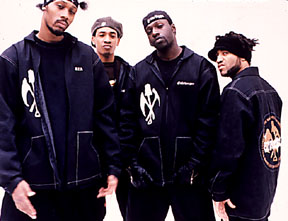
Paul Edward Huston, better known by his stage name Prince Paul, is an American record producer, disc jockey and recording artist from Amityville, New York. Paul began his career as a DJ for Stetsasonic. He has worked on albums by Boogie Down Productions, Gravediggaz, MC Lyte, Big Daddy Kane and 3rd Bass, among others. Major recognition for Prince Paul came when he produced De La Soul's debut album 3 Feet High and Rising (1989), in which he pioneered new approaches to hip hop production, mixing and sampling, notably by including comedy sketches.

Wu-Tang Clan is an American hip hop collective formed in Staten Island, New York City, in 1992. Its members include RZA, GZA, Method Man, Raekwon, Ghostface Killah, Inspectah Deck, U-God, Masta Killa, and, until his death in 2004, Ol' Dirty Bastard. Close affiliate Cappadonna later became an official member. They are credited for revitalizing East Coast hip hop and are considered one of the greatest hip hop groups of all time.

3 Feet High and Rising is the debut studio album by the American hip hop group De La Soul, released on March 3, 1989, by Tommy Boy Records. It was the first of three collaborations with the producer Prince Paul, and was the critical and commercial peak of both parties. The album title comes from the Johnny Cash song "Five Feet High and Rising". The album contains the singles "Me Myself and I", "The Magic Number", "Buddy", and "Eye Know".

Enter the Wu-Tang is the debut studio album by the American hip-hop group Wu-Tang Clan, released on November 9, 1993, by Loud Records and RCA Records. Recording sessions took place during late 1992 to early 1993 at Firehouse Studio in New York City, and the album was produced by the group's de facto leader RZA. Its title originates from the martial arts films Enter the Dragon (1973) and The 36th Chamber of Shaolin (1978).

Life After Death is the second and final studio album by American rapper the Notorious B.I.G., released on March 25, 1997, on Bad Boy Records and Arista Records. A double album, it was released sixteen days after his murder. It features collaborations with guest artists such as 112, Jay-Z, Lil' Kim, Mase, Bone Thugs-n-Harmony, Too $hort, Angela Winbush, D.M.C. of Run-D.M.C., R. Kelly, the Lox, and Puff Daddy. Life After Death exhibits the Notorious B.I.G. further delving into the mafioso rap subgenre. The album is a sequel to his first album, Ready to Die, and picks up where the last song, "Suicidal Thoughts", ends.
Stetsasonic is an American hip hop band. Formed in 1981 in Brooklyn, New York City, New York, Stetsasonic was one of the first hip hop acts to perform with a full band and use live instrumentation in their recordings, paving the way for future hip hop bands such as The Roots. The band combined beat-boxing, sampling technology, and live band performance, incorporating R&B, jazz, dancehall reggae, and rock into its sound. Stetsasonic is also considered one of the acts that pioneered jazz rap.

Gravediggaz was an American hip hop group from New York, known for its dark sense of humor and abrasive, menacing soundscapes. Gravediggaz blended hardcore hip hop, gangsta rap and heavy metal with horror elements to pioneer the hip-hop subgenre of horrorcore.
Horrorcore, also called horror hip hop, horror rap, death hip hop, death rap, or murder rap is a subgenre of hip hop music based on horror-themed and often darkly transgressive lyrical content and imagery. Its origins derived from certain hardcore hip hop and gangsta rap artists, such as the Geto Boys and Three 6 Mafia, which began to incorporate supernatural, occult, and psychological horror themes into their lyrics. Unlike most hardcore hip hop and gangsta rap artists, horrorcore artists often push the violent] content and imagery in their lyrics beyond the realm of realistic urban violence, to the point where the violent lyrics become gruesome, ghoulish, unsettling, inspired by slasher films or splatter films. While exaggerated violence and the supernatural are common in horrorcore, the genre also frequently presents more realistic yet still disturbing portrayals of mental illness and drug abuse. Some horrorcore artists eschew supernatural themes or exaggerated violence in favor of more subtle and dark psychological horror imagery and lyrics.

Hip hop production is the creation of hip hop music in a recording studio. While the term encompasses all aspects of hip hop music creation, including recording the rapping of an MC, a turntablist or DJ providing a beat, playing samples and "scratching" using record players and the creation of a rhythmic backing track, using a drum machine or sequencer, it is most commonly used to refer to recording the instrumental, non-lyrical and non-vocal aspects of hip hop.

The Pick, the Sickle and the Shovel is the second studio album by hip hop supergroup Gravediggaz. Released on September 16, 1997, via Gee Street, V2 and BMG Records, the album has a more socially conscious sound and is considerably calmer than its predecessor; it features heavy production input by the RZA and his production team the Wu Elements.

Nightmare in A-Minor is the third and final studio album by the hip hop supergroup Gravediggaz, recorded by two remaining members and released after Poetic's death.

Anthony Ian Berkeley better known as Too Poetic, was an American rapper and producer. He was also a founding member of the hip-hop group Gravediggaz, for which he used the alias Grym Reaper. He also used the alias Tony Titanium.
Brothers Grym was a New York hip-hop group formed by Too Poetic and his two younger brothers, lyricists Brainstorm and R&B hip-hop producer E#.

"C.R.E.A.M." is a song by the American hardcore hip hop group Wu-Tang Clan, released on January 31, 1994 by Loud Records, as the second single from their debut studio album Enter the Wu-Tang (1993). The song was produced by the group's de facto leader RZA, and contains a sample of the Charmels' 1967 song "As Long As I've Got You" throughout. It features two verses from members Raekwon and Inspectah Deck, who discuss their upbringings while living in New York City, and Method Man, who sings its hook. Its music video, featuring all Wu-Tang Clan members in New York City, was released in 1994.
Flatlinerz is a horrorcore group from New York City. They are responsible for introducing the term "horrorcore" with their 1994 release U.S.A. .

The discography of Wu-Tang Clan leader RZA consists of four studio albums, two compilation albums, one instrumental album, four extended plays and five singles.

"Diary of a Madman" is the debut single by the Gravediggaz, released in June 1994 from their debut album, 6 Feet Deep. The song was produced by members RZA and Prince Paul along with RNS and featured verses from Killah Priest and Scientific Shabazz. "Diary of a Madman" was Gravediggaz' most successful single, peaking at No. 82 on the Billboard Hot 100, their only single to reach the chart, as well as No. 8 on the Hot Rap Singles chart.

"1-800 Suicide" is the third and final single released from the Gravediggaz' debut album, 6 Feet Deep. Produced by Prince Paul, "1-800 Suicide" was the Gravediggaz final charting single, making it to 46 on the Hot Rap Singles. The song was paired with "Mommy, What's a Gravedigga?" as a Double A-Side, although Gee Street also released "1-800 Suicide" and "Mommy, What's a Gravedigga?" as individuals with exactly the same cover art. The song can also be found on the soundtrack of the 1995 film Tales from the Crypt presents: Demon Knight, and as the opening theme song for The Leftovers Season 3 episode "Certified".

Robert Fitzgerald Diggs, better known by his stage name RZA, is an American rapper, actor, filmmaker, and record producer. He is the de facto leader of the hip hop group Wu-Tang Clan, having produced most albums for the group and its respective members. He is a cousin of two other original Wu-Tang Clan members: GZA and Ol' Dirty Bastard. He has also released solo albums under the alter-ego Bobby Digital, along with executive producing credits for side projects. After forming the Wu-Tang Clan, RZA was a founding member of the horrorcore group Gravediggaz, since 1992, where he went by the name The RZArector.

Wu-Tang Forever is the second studio album by the American hip hop group Wu-Tang Clan, released June 3, 1997, by Loud and RCA Records in the United States. Pressed as a double album, it was released after a long run of successful solo projects from various members of the group, and serves as the follow-up to their debut album Enter the Wu-Tang . Forever features several guest appearances from Wu-Tang affiliates Cappadonna, Streetlife, 4th Disciple, True Master, and Tekitha. The original run of compact discs featured an enhanced CD which allowed users to walk around the "Wu Mansion" and access additional content.
















